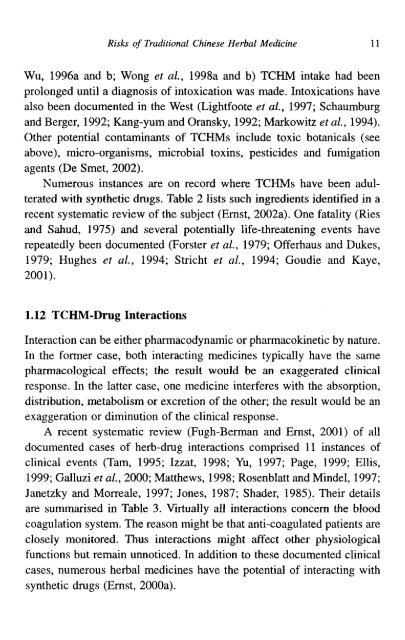Chinese Medicine - Modern Practice (252 pages)
Chinese Medicine - Modern Practice (252 pages)
Chinese Medicine - Modern Practice (252 pages)
- TAGS
- cs5235.userapi.com
You also want an ePaper? Increase the reach of your titles
YUMPU automatically turns print PDFs into web optimized ePapers that Google loves.
Risks of Traditional <strong>Chinese</strong> Herbal <strong>Medicine</strong> 11<br />
Wu, 1996a and b; Wong et al., 1998a and b) TCHM intake had been<br />
prolonged until a diagnosis of intoxication was made. Intoxications have<br />
also been documented in the West (Lightfoote et al., 1997; Schaumburg<br />
and Berger, 1992; Kang-yum and Oransky, 1992; Markowitz et al., 1994).<br />
Other potential contaminants of TCHMs include toxic botanicals (see<br />
above), micro-organisms, microbial toxins, pesticides and fumigation<br />
agents (De Smet, 2002).<br />
Numerous instances are on record where TCHMs have been adul-<br />
terated with synthetic drugs. Table 2 lists such ingredients identified in a<br />
recent systematic review of the subject (Ernst, 2002a). One fatality (Ries<br />
and Sahud, 1975) and several potentially life-threatening events have<br />
repeatedly been documented (Forster et al., 1979; Offerhaus and Dukes,<br />
1979; Hughes et al., 1994; Stricht et al., 1994; Goudie and Kaye,<br />
2001).<br />
1.12 TCHM-Drug Interactions<br />
Interaction can be either pharmacodynamic or pharmacokinetic by nature.<br />
In the former case, both interacting medicines typically have the same<br />
pharmacological effects; the result would be an exaggerated clinical<br />
response. In the latter case, one medicine interferes with the absorption,<br />
distribution, metabolism or excretion of the other; the result would be an<br />
exaggeration or diminution of the clinical response.<br />
A recent systematic review (Fugh-Berman and Ernst, 2001) of all<br />
documented cases of herb-drug interactions comprised 11 instances of<br />
clinical events (Tam, 1995; Izzat, 1998; Yu, 1997; Page, 1999; Ellis,<br />
1999; Galluzi et al., 2000; Matthews, 1998; Rosenblatt and Mindel, 1997;<br />
Janetzky and Morreale, 1997; Jones, 1987; Shader, 1985). Their details<br />
are summarised in Table 3. Virtually all interactions concern the blood<br />
coagulation system. The reason might be that anti-coagulated patients are<br />
closely monitored. Thus interactions might affect other physiological<br />
functions but remain unnoticed. In addition to these documented clinical<br />
cases, numerous herbal medicines have the potential of interacting with<br />
synthetic drugs (Ernst, 2000a).
















